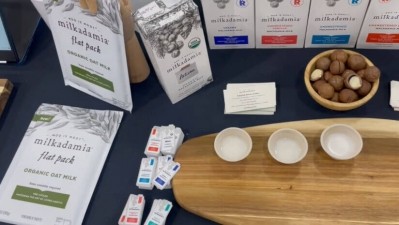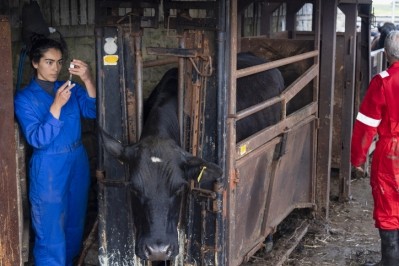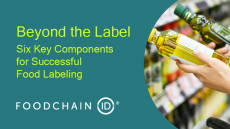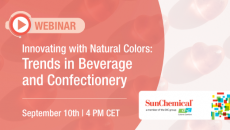ADM on the farm: Building regenerative agriculture builds business opportunities
But to fully seize this potential and establish a competitive edge, farmers, suppliers and manufacturers must work together to expand adoption of regenerative agriculture in a way that meets consumer expectations, delivers real environmental impact and offers commercial benefits across the value chain.
A long-time advocate for sustainable agriculture, ADM is helping more farmers test and embrace regenerative practices and connecting the dots for CPG manufacturers about the added value and business opportunities of sourcing from farms that practice regenerative agriculture.
Defining regenerative agriculture and setting realistic expectations
A foundational roadblock to reaping the rewards of regenerative agriculture, both environmentally and commercially, is a lack of a formal, legal definition, which hinders adoption of and investment in the practices.
To address this, ADM worked closely with stakeholders across the value chain to create a standardized but flexible definition.
“Since it is so new, it is good for the industry to come together on standardizing what they mean on regenerative agriculture for a couple of different reasons,” Paul Scheetz, director of Climate Smart Ag Origination at ADM, told FoodNavigator-USA.
The first, he explained, is adopting regenerative agriculture practices needs to be a commercial or business opportunity, not a compliance exercise, which means companies within the supply chain need to set shared, measurable expectations.
The second is to create consumer demand, shoppers need to know what regenerative agriculture is and why it is worth a premium.
“Aligning on what the definition of regenerative agriculture is, or at least being in the ballpark, is going to be pretty critical on trying to shrink what that education curve looks like,” Scheetz said.
ADM defines regenerative agriculture as practices based on indigenous ways of land management that are adaptive to local and physical conditions and culture, and which centers on five main principles.
“The five principles that we have under regenerative agriculture are minimizing soil disturbance, like you will see in a conservation-till or no-till program, maintaining living roots, always covering bare soil – which both of those could be cover crops [or] they could be tillage practices – four is diverse crops in the form of diverse crop rotations or also a diversity in field operations … and then the fifth is responsibly manage inputs,” Scheetz explained.
He added, “Now, when we design our programs around those five principles, the one thing that we understand is that every commodity and every region has its own story, has its own nuance. So, there is not a requirement to hit all five principles, because soy bean in Des Moines is completely different than canola in the UK."
Regenerative agriculture can counter climate change, increase farmer margins
Given the concept of regenerative agriculture is relatively new, many farmers are hesitant to adopt the practices, which initially could increase their costs and threaten their harvest yields if implemented unsuccessfully.
But for third-generation farmer Kyle Schminke, who took over from his father his grandparents’ farm in Shellsburg, Iowa, adopting regenerative agriculture offered him a way to counter climate change and, with help from ADM, earn more money.
“Conventional farming is very time consuming. It is very expensive because you have to have extra equipment, you have to have more manpower, you have to have fuel and everything else, so it is way more expensive” than well-implemented regenerative agriculture practices, Schminke told FoodNavigator-USA at his family farm.
As he grew his farm, he said, “it was even more imperative to make it easier for me,” which is when he first adopted the regenerative practice of no tilling.
Encouraged by the benefits he saw, he decided to adopt a second regenerative practice: adding cover crops.
Unlike no tilling, though, Schminke said his initial attempt at planting cover crops was unsuccessful and discouraging. A few years later he tried again with new equipment and benefited in the spring when his farm was spared massive erosion that negatively impacted his neighbors.
“Once the soil leaves you, it is gone forever. When it gets in the water – like when you drive by these rivers and streams and they are brown, that is because of the dirt that has left. So, our big thing is that we do not want that to happen, and by having these regenerative crops out there, you do not have that,” he explained.
ADM re:generations incentivizes farmers to adopt regenerative agriculture practices
Not all farmers are in a financial position to underwrite the initial investments necessary to practice regenerative techniques at scale, efficiently and profitably like Schminke, which is where initiatives like ADM’s re:generations program can help.
“ADM re:generations is the farmer facing program that we have that provides incentives and technical assistance to farmers to adopt practices on their farms, including cover crops. And then we also have an incentive that is paid on the bushel, which is what farmers deliver to us every day. So, we have opportunity to add value to the crop and then also compensate them for the practice that they are doing on farm that do things like improve water quality, reduce erosion and put carbon in the soil,” Theo Gunther, Iowa program manager for ADM's re:generations, told FoodNavigator-USA.
“So, my goal is to get farmers enrolled in our programs familiar with what we have to offer. Then we work with a platform called Gradable, which is [our] farmer’s business network that farmers can enter their data into, and then that is what is used to calculate those outcomes,” Gunther added.
Entering its third year, ADM’s re:generations program is still in its early days, but it is growing quickly with more than 2.8 million acres globally enrolled in 2023 and an ambitious goal to enroll 3.5 million in 2024 and 4 million to 5 million acres globally in 2025.
The business case for suppliers, CPG manufacturers to invest in regen ag
For now, ADM and its partners are paying for the program to reduce carbon intensity in its supply chain. But as the re:generations program scales up from the initial pilots that began in 2012, ADM simultaneously is building demand with the intention that part or all of the incentives one day will be covered by end consumers, who research shows are more likely to trust and buy from brands that support regenerative agriculture.
“Everything that we do in our business, the reason why we have been around for 120 years, is because we have depended on the land that farmers ultimately manage and grow crops that we turn into agriculture, ingredients that go into the food, fuel, feed and industrial space, so we are very dependent on that land. And the one thing that we understand over the last decade, and what we expect for the next future decades, is those crops are probably more at risk than they have ever been, with different weather patterns that you could ultimately see,” Scheetz said.
He explained investing in regenerative agriculture can improve water filtration during droughts, ease soil erosion in windy years, improve biodiversity and reduce carbon intensity, in general, which in turn can help CPG companies reduce stubborn Scope 3 emissions.
“Whenever we look at our Scope 3 emissions, and [when] a lot of our downstream customers look at their Scope 3 emissions, they will find … the biggest contributor of greenhouse gas emissions tends to be field level emissions. They will make up anywhere from 60% to 90%,” Scheetz explained.
“With that big of a contribution to the overall carbon emissions of whatever product that is ultimately being made, it creates an opportunity to incentivize practices in a different way than we have in the past,” he added.
“So, for the better part of the last 120 years, the way that we have incentivized farmers has been around productivity and cost. And if we can have that different type of conversation for the next decade and decades, that is when, I think, ultimately, a lot of the CPGs will be able to hit their targets, we will be able to hit our targets, and we will make significant impact through the agriculture supply chain,” he said.
Regenerative agriculture can help brands standout, build consumer loyalty
Beyond helping companies hit their Scope 3 and environmental sustainability goals, Scheetz says sourcing regeneratively grown ingredients can help brands and retailers standout, earn consumer loyalty and ultimately drive sales and potentially command higher price points.
According to ADM’s Farming for the Future survey, more than 70% of consumers will be loyal to brands that have a sustainability story and are investing in sustainability. Likewise, when regenerative agriculture was defined for consumers, more than 70% said they would be more loyal to brands that invested in the practices.
The survey also highlighted some of the challenges in sourcing regeneratively farmed crops, with more than 90% of CPGs and retailers mentioning that it is critical to have good partners in establishing successful regenerative agriculture programs in large part because there is not always visibility to the farm level.
“That is really what our role is, from an ADM perspective, is making sure that we can design programs that help … CPG [companies] specifically make aggressive goals and hit aggressive goals, because we are positioned between farmers and CPGs,” Scheetz said.
Call to action: partnerships, pilots and patience
Realizing the full environmental and business benefits of regenerative agriculture requires partnerships, pilots and patience, according to Scheetz, who acknowledges all three can be intimidating but adds they are achievable if companies adopt an attitude of “progress over perfection.”
“Getting started comes with way more education than reading through an 80 page protocol on what regen ag ultimately is, especially if it includes meeting with farmers, especially if it includes outcomes reports that talk about not only carbon, but biodiversity, soil erosion, water quality as well,” Scheetz said.
He advises interested stakeholders set aside sufficient time – upwards of 18 months – to pilot regenerative agriculture practices. He also advises them to find partners.
“You will not have a successful program doing it on your own. You have to partner and collaborate both – from an ADM perspective – upstream and downstream. So, upstream with farmers, downstream with CPGs or different market opportunities. There has to be a conversation that is consistently going on to make sure that you are meeting the needs of farmers upstream and downstream … at the same time,” he explained.
He continued, “When we design our program, we try to design it with the thought of progress over perfection, which is super critical, because if I would speak to a CPG audience today, it would be that you can get lost in the sauce of GHG protocols or accounting methods or methodologies. ... Just getting started, you will learn significantly more than you will being an expert in any of those processes. So understanding there is going to be a level of uncertainty in designing any program whatsoever, but as long as you are building a program that works at the field level, at the farm level, specifically, that keeps in mind what their big focus areas are, which is financial sustainability and then being able to pass that piece of ground on, not only to their kids, but to their kids' kids, that will give you the ability to scale up.”
Finally, Scheetz said, CPG companies and other stakeholders should not wait to act if they have ambitious Scope 3 emission reduction or other environmental sustainability goals for 2030 or beyond.
“It is hard to go from zero to 100,” he explained. “There has almost got to be this gradual build up to be able to accomplish those goals.
Videography, editing & production: Carly Rude
















